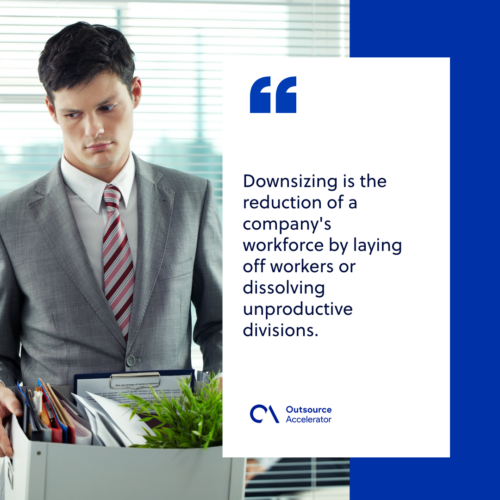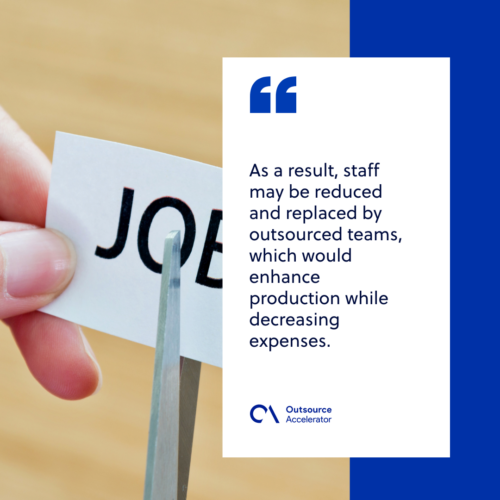Downsizing
Definition
What is downsizing?
Downsizing is the reduction of a company’s workforce by laying off workers or dissolving unproductive divisions. It is a common organizational practice, typically associated with economic crises and failing businesses.

How does downsizing work?
The organization typically informs particular employees that they are being laid off during a downsizing. These are usually long-term layoffs.
Layoffs are frequently followed by other changes, such as branch closures or department consolidation. After a corporation downsizes, there may be changes in the day-to-day work, and staff may have to take on new responsibilities as a result of the reduced workforce.
Causes of employee downsizing
A company may downsize for various reasons, including:
Cost-cutting
One of the main goals for downsizing employees is to cut company costs. Employee benefits and the operating costs associated with overproduction are equally costly to businesses.
Productivity
Companies may reduce their workforce to boost productivity. On the surface, this may appear irrational, but there are times when it is useful.
When downsizing, a business may boost production by replacing workers with advanced equipment that can perform or automate the same tasks.
Value
When a corporation reduces the number of employees, it usually means that some restructuring and adjustments are in the works. These adjustments are usually made to increase the company’s profitability.
The value of the firm stock will rise if shareholders and other investors believe the company will make improvements that will increase profitability.
Outsourcing
It may be in the best interests of the company’s owners to narrow the company’s focus by eliminating certain parts of the production.
As a result, staff may be reduced and replaced by outsourced teams, which would enhance production while decreasing expenses.

How to manage downsizing employees
Here are some practical strategies for minimizing the disruption and negative impacts of downsizing on your firm.
Be honest and upfront
When layoffs and downsizing plans are in the works, you and your management must be as open as possible. Be honest with your employees about the reason for the downsizing.
Maintaining transparency will help curb rumors, which can cause concern and distraction among workers. Employees are more likely to remain engaged and enthusiastic amid a change if they’re not left making guesses about what will happen next.
Set new goals and tasks
It is typical for employees to be unsure of the organization’s direction following a downsizing. Increase the frequency of team and individual meetings during this stressful period.
Establish goals between meetings to give staff something to focus on. Employees will feel motivated and remain loyal to the company if they know that there’s still room to grow professionally and personally in the organization.

Have a clear transition plan
It will be tough to work in the same way with less staff. You must have a strategy in place so that employees can transition easily into their new responsibilities and company activities do not fall behind.
When appropriate, cross-train employees so that particular responsibilities and functions are not neglected when those in charge are let go. You don’t want one employee to feel overburdened because they’re the only one who knows a task.
Pay attention to small details
After you’ve reduced your staff, you’ll want to focus on positive actions that will keep employees motivated. Set goals for your staff and help them stay on track. Allow team members to understand the goals and if they are meeting them.
Paying attention to details and offering feedback will guarantee that employees prioritize company goals.
Be compassionate and understanding
Downsizing makes the remaining employees work extra for the company. As an employer, you should understand that this can be difficult for them.
Ask them how downsizing will affect their daily routine and be considerate. Giving employees tasks that they are familiar with can make them stay in the company.







 Independent
Independent




